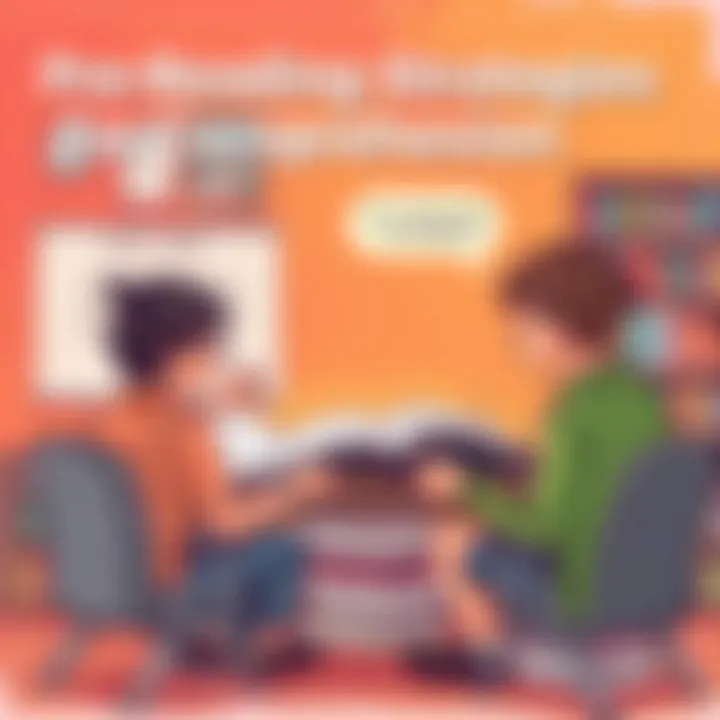Techniques to Enhance Speed and Comprehension in Reading


Intro
Reading efficiently is a skill that can genuinely transform how we approach books. It is not merely about flipping through pages at breakneck speed; it’s about diving deep into the content while processing information effectively. With the myriad of distractions in today’s world, mastering reading techniques has become more essential than ever. This article discusses actionable strategies that allow readers to enhance both their reading speed and comprehension levels. By understanding how to engage with texts better, individuals can unlock a treasure trove of knowledge.
Pre-Reading Strategies
Before one even opens a book, there are steps that can set the tone for an effective reading experience. Taking a moment to glance through the table of contents or headings provides a roadmap of the text ahead. For example, if you’re diving into a book on environmental science, reviewing chapters on climate change may prepare your mind for the complex discussions that follow.
Another useful tactic includes making predictions. After skimming the introduction, ask yourself questions like, “What do I expect to learn from this chapter?” This primes the brain to be alert for pertinent information. This method activates prior knowledge and can enhance the retention of new knowledge.
Active Reading Techniques
Once you’re into the text, it’s all about engagement. Here, active reading techniques come into play. One effective approach is to annotate the text. Underlining key points, jotting down thoughts in the margins, or summarizing paragraphs can facilitate better understanding. For instance, a child reading a fantasy book might underline themes related to friendship and bravery, creating a visual cue that enhances memory recall.
Chunking
Chunking is a brilliant method where large blocks of text are broken down into smaller, manageable sections. This not only eases comprehension, especially for young readers, but also helps in maintaining focus. For instance, instead of trying to process five dense paragraphs in one go, breaking them down into bite-sized pieces makes the content less daunting.
Post-Reading Techniques
After the final page is turned, reflections are essential. Summarizing what you’ve read in your own words consolidates understanding. For instance, after finishing a book, a kid could chat with a parent about the story's ending and discuss lessons learned. Furthermore, related activities—like drawing a favorite scene—can unleash creativity while reinforcing the information.
In summary, mastering reading techniques is key in our information-heavy society. It allows readers to not just skim through text but to engage deeply, ensuring retention and comprehension.
Key Takeaways
- Pre-Reading: Skim content to set expectations.
- Active Reading: Annotate, highlight, and engage with the text actively.
- Chunking: Break down large paragraphs into smaller sections.
- Post-Reading: Reflect through summaries or creative activities to seal in knowledge.
Incorporating these techniques can not only enhance one’s reading skills but also make the process far more enjoyable. With a bit of practice and persistence, anyone can transform their reading habits to become rapid and effective!
For more tips on enhancing your reading experience, you can check out resources from Wikipedia or Britannica.
Understanding the Purpose of Reading
By identifying what we hope to achieve—whether it’s improving our knowledge, finding entertainment, or enhancing our empathy—we can significantly enhance our engagement with various materials. This focus not only saves time but also enriches the overall reading experience. Like determining the destination before setting out on a journey, understanding the purpose of reading lays the groundwork for effective strategies that follow.
Identifying Objectives
When diving into a book, it's helpful to first pinpoint your objectives. Ask yourself key questions: Are you reading for pleasure, education, or perhaps to gather information for a specific task? Identifying your goals plays a crucial role in how you approach the text. Here are a few considerations:
- Pleasure: If you're reading for leisure, allow yourself to enjoy the narrative, letting it unfold at its own pace. This might mean savoring every word or simply flipping through pages to soak up an exciting plot.
- Education: For those aiming to expand their knowledge, focus on sections that deeply resonate with your learning objectives. You might want to take notes or highlight important information as you read.
- Information Gathering: If you're searching for specific insights or data, honing in on relevant chapters or sections can optimize your time. Skimming through headings and subheadings will help direct you efficiently.
Equipped with clearly defined objectives, readers can drive their focus and make intentional choices with every text they encounter.
Differentiating Genres
The variety of genres available can drastically affect your reading strategy. Fiction, non-fiction, poetry, and technical manuals all carry distinct characteristics that require different approaches. Recognizing these differences can make a world of difference in how rapidly you absorb the material.
- Fiction: Reading novels often invites a leisurely pace. You engage with characters and plots, immersing yourself in their worlds. However, it may be smarter to skim through less crucial scenes if you're short on time but still want to grasp the overall plot.
- Non-Fiction: In contrast, non-fiction demands a more analytical approach. You might want to identify key concepts, take notes, and reflect on how they relate to your existing knowledge.
- Poetry: Poetry tends to be rich in emotion and imagery, often requiring a slower read to unpack its potential meanings. A serious reader may benefit from reading aloud, letting the rhythm and emotion seep in.
- Technical Manuals: These texts often present information in a straightforward manner. It’ll be useful to focus on bullet points, list outlines, or cues that make retrieving information easier later on.
Understanding the genre helps you adjust your reading methods accordingly, ensuring that you're employing the right tools for each type of book. This way, whether you're flipping through a captivating novel or dissecting a complex scientific paper, you’ll be better prepared to approach the text efficiently.
Creating a Conducive Reading Environment
Creating a conducive reading environment is like setting the stage for a play; it can dramatically affect the outcome. The right atmosphere encourages engagement, enhances comprehension, and promotes faster reading. Imagine diving into a captivating story or complex concept in a space that feels right—cozy lighting, soft textures, and minimal interruptions. This section focuses on the tangible elements that can transform your reading experience from ordinary to extraordinary.
Minimizing Distractions
Distractions are the unwelcome guests that tend to crash the reading party. Whether it’s a phone buzzing with notifications, loud conversations in the background, or even a cluttered desk, these interruptions can pull focus away from the text. Think about it this way: if you’re in a crowded café, how likely are you to immerse in that thrilling novel?
To minimize distractions:
- Choose Your Space Wisely: Consider quiet locations like libraries or cozy corners of your home where interruptions are rare.
- Turn Off Notifications: Silence your phone and other devices while reading. Better yet, keep them out of reach to avoid temptation.
- Establish Reading Time: Set specific times that are just for reading. Let those around you know these times are off-limits for interruptions.
By intentionally creating a distraction-free zone, you allow your mind the freedom to wander through the pages, absorbing every detail without competing thoughts intruding.
Setting a Comfortable Space
Now that distractions have been addressed, let’s talk comfort. A reading environment doesn't just need to be free of distractions; it should also feel welcoming. Imagine you’re about to settle down with a book. Do you want a stiff chair or a plush sofa? A good reading nook can make all the difference.
To set a comfortable space:
- Invest in the Right Furniture: A supportive chair or a couch can invite longer reading sessions. Add some cushions for an extra touch of coziness.
- Lighting Matters: Invest in good lighting. Whether it’s daylight or a soft lamp, ensure your reading area isn’t too harsh or dim. Ideally, you want something that soothes yet illuminates.
- Organize Your Materials: Keep your books and notebooks within reach but organized. A tidy space can elevate your mental state and let you focus better.
In the end, the maximum engagement comes when readers feel at ease. Creating a comfortable haven ensures that reading becomes something to look forward to, a retreat from the hustle or a moment to reflect.
"A great book provides an escape but only when the environment welcomes you in."
Remember, the right setting is about personal preference, tailoring your reading nook to your likes. Don’t be shy to shake things up based on what vibes with your mood. Happy reading!
Pre-Reading Strategies
Before diving into a book, it’s essential to lay a solid groundwork through pre-reading strategies. These techniques can significantly enhance both your reading speed and comprehension levels, ensuring that you grasp the essence of the material without getting lost in the details. By understanding what to expect and organizing your approach, you can make the most of your reading time.
Skimming and Scanning Techniques
Skimming and scanning are handy tools that allow readers to navigate texts with efficiency. They are much like taking a quick peek inside a box before deciding whether to open it fully.
Skimming involves swiftly glancing through the material to get the gist of its main ideas. This technique is about seeing the forest for the trees. You may start by reading the title, headings, and subheadings, followed by the introductory and concluding paragraphs. Here are a few tips to improve your skimming:
- Focus on bold or italicized text, as it often highlights crucial points.
- Read the first sentence of each paragraph. Since the main idea is often found there, it can save you time.
- Look for images, graphs, or charts, which can convey information quickly and effectively.
On the other hand, scanning is like a treasure hunt, where you aim to find specific information or keywords within a text. It requires a keen eye and clear goals. Here’s how to scan effectively:
- Have a question in mind—this can guide your search and make it quicker.
- Move efficiently down the page, using your finger or a pen to track where you are, preventing your eyes from wandering.
- Be aware of the layout of the text. Different styles—such as bullet points or numbered lists—can help direct your search.
Reviewing Summaries and Indexes
Before diving deep into a book, checking out summaries and indexes can provide you with a roadmap of the content. This practice is akin to looking at a map before hitting the road—it's all about knowing your destination.
Summaries offer brief overviews of each chapter or the entire book. They usually encapsulate the key arguments, ideas, and themes. Here are some ways to maximize the benefits of summaries:


- Read them with a critical eye to gauge the relevance of the content.
- Take notes of the primary arguments to help engage with the material later.
- Compare the summaries with your reading objectives to ensure alignment.
On the flip side, indexes serve as a detailed list, organizing the book's content based on topics, names, or locations mentioned within. Here’s how to take full advantage of indexes:
- If you’re looking for a specific theme or idea, check the index first to locate relevant sections quickly.
- Use the index to familiarize yourself with the structure of the book, enabling you to navigate without fumbling around.
In summary, pre-reading strategies such as skimming, scanning, and reviewing can set the stage for a more productive reading experience. They help form a framework that contextualizes your reading, ultimately leading to enhanced retention and understanding. By investing time in these techniques, readers can transform how they approach literature, making reading feel less like a chore and more like a journey.
Active Reading Techniques
Active reading is a crucial aspect of enhancing one's reading skills, especially when the goal is to absorb information quickly and effectively. This method involves engaging directly with the text in a manner that promotes better comprehension and retention. Unlike passive reading, where the reader merely glides through the pages without much thought, active reading requires thoughtful interaction with the material.
When an individual practices active reading techniques, they tend to extract value from reading sessions more effectively. This could be likened to making a fine soup: if you just toss in vegetables and hope for the best, the result might be flavorless. But if you stir, taste, and adjust your ingredients as you cook, you get something truly delightful. Similarly, by actively engaging with a book, one can uncover richer meanings and insights.
Some key elements of active reading include highlighting, notetaking, and questioning the material. Each of these strategies leads to a deeper understanding of the content. For example, when you highlight essential passages, you’re not just marking text; you’re creating a roadmap of ideas that are significant for future recall.
Highlighting Key Points
Highlighting is often seen as one of the simplest yet most effective techniques within active reading. It's not just about slapping a neon yellow mark on a passage because it looks important. Instead, it involves a careful selection of key phrases and ideas that encapsulate the author’s primary arguments. This process encourages the reader to think critically about what they’re reading, narrowing down the vast ocean of text into a few significant islands of understanding.
To make highlighting more effective:
- Choose Wisely: Not everything deserves a highlighter. Focus on main ideas, critical arguments, or crucial data.
- Be Consistent: Create a system for how you highlight. For example, use one color for facts and another for themes.
- Review: After reading, skim through what you’ve highlighted to reinforce the material.
As you engage with the text and reflect on your highlights, you might start noticing patterns or gaining insights that you missed on a first read-through. Highlights can serve as a springboard for deeper discussions, making it easier to share insights with peers or to revisit your thoughts later.
Taking Notes and Marginalia
Notetaking is another fundamental technique that complements active reading wonderfully. Writing down thoughts in a notebook or directly in the margins of the book can serve multiple purposes. It can clarify your thinking, track your emotional responses to the text, or even pose questions that arise as you read. This tactic is akin to sketching in the margins of a masterpiece: it adds depth and personal connection to the experience.
Consider these elements when taking notes:
- Summarize: Capture the essence of a section in your own words. This not only aids in understanding but also aids memory retention.
- Engage Critically: Ask questions or jot down your thoughts. For instance, "Why did the author choose this anecdote?" or "How does this relate to what I know?"
- Connect Ideas: Draw connections to other texts, concepts, or personal experiences. Connections can weave narratives that make the material more relevant to your life.
Remember, the goal of notetaking is not merely to have a record of what you've read, but to create a dialogue between you and the text. If done right, your notes can become a reflective pool where ideas are examined from different angles, encouraging a more profound understanding.
As you navigate your reading journey using these active reading techniques, recognize that comprehension isn't a destination but a continuous process of engagement. By adding this dynamic element to your reading practice, you'll find yourself not just speed-reading, but truly connecting with and understanding what you read.
Speed Reading Techniques
Reading quickly while still grasping the essence of a text is more than just a party trick; it’s an essential skill in today's fast-paced world. In this article, we delve into speed reading techniques, which can help readers maneuver through vast amounts of information efficiently. The benefits range from saving time to improving overall comprehension and retention. However, diving into these techniques requires consideration of one’s reading style and the type of material being tackled.
Utilizing Tools and Apps
With technology at our fingertips, it's no surprise that numerous tools and applications can aid in speed reading. These digital helpers often employ methods that promote faster reading habits. For instance, e-readers like Kindle have built-in features that adjust text for ease of reading. You can find apps such as Blinkist that summarize books into bite-sized chunks. This sort of summarization allows readers to grasp main ideas quickly, providing a solid foundation before digging deeper into the full text. Other notable tools include Spreeder and Reasy which train your eyes to read faster with rapid serial visual presentation. The key is to experiment with different tools to find which one resonates with you, as everyone has unique preferences.
Practicing Eye Movement Control
Another critical aspect of speed reading revolves around eye movement. Most people are accustomed to a pattern of regressing, or backtracking, while reading. This habit slows down reading speed considerably. By practicing eye movement control, one can train the eyes to focus on groups of words rather than individual words. Techniques such as using a pointer or finger to guide your eyes can foster smoother and quicker reading. Additionally, apps that track your eye movements can provide feedback and adjust your techniques accordingly.
"Reading is a basic tool in the living of a good life." — Joseph Addison
By honing these eye movement strategies, readers can enjoy increased fluency and comprehension. Speed reading is not merely about skimming through words but about engaging with the material in a way that enriches understanding while also saving time. Remember, if the material is particularly complex, speed may take a backseat. Knowing when to speed read and when to slow down is an art in itself.
For more insights on effective reading, check resources such as Wikipedia, or platforms dedicated to education like Britannica. Engaging with communities on Reddit can also provide valuable tips and shared experiences from fellow readers.
Comprehension Improvement Techniques
Reading efficiently goes beyond just turning the pages quickly; it’s about grasping the essence of what's written. Comprehension improvement techniques are essential tools for any reader aiming to absorb information effectively while maintaining a brisk pace. By focusing on comprehension, readers are better equipped to recall and apply knowledge, ensuring that their time spent reading yields tangible benefits. These techniques not only enhance understanding but also foster critical thinking, allowing readers to connect ideas and engage in deeper analyses of texts.
Asking Analytical Questions
When engaging with a text, one of the most productive methods to bolster comprehension is through asking analytical questions. This technique involves challenging the content rather than passively accepting it. For instance, after reading a chapter, consider questions like:
- What is the main argument the author is trying to convey?
- How does this information tie in with what I already know?
- Are there any underlying assumptions made by the author?
By interrogating the material, readers aren’t just skimming the surface; they dig deeper, uncovering layers of meaning. This method turns reading from a passive activity into an interactive experience, allowing readers to engage more fully with the text and remember details more effectively.
Summarizing Sections
Another powerful technique for improving comprehension is summarizing sections after reading. This practice entails distilling key points into concise statements. Here’s a suggested approach:
- Identify Key Ideas: After completing a section, pinpoint the main concepts. What are the takeaways?
- Write a Brief Summary: In your own words, write a few sentences that capture the gist of what you've read. This reinforces memory retention and understanding.
- Review Regularly: Revisit your summaries before starting new sections or chapters. Doing so refreshes your memory and helps solidify information.
Incorporating these summarizing techniques into your reading habit not only heightens comprehension but also serves as a reference point for future discussions or analyses. When one reflects on the material, they often find connections and insights that may not have been evident during the initial reading.
"Reading is not just about what you see in the text; it's about what happens in your mind alongside those words."
By employing methods such as questioning and summarizing, readers can greatly enhance their understanding, making each reading session more productive and insightful.
Post-Reading Strategies
In the quest for reading rapidly yet effectively, post-reading strategies emerge as crucial to consolidating understanding and retaining knowledge. After navigating through the lines and pages of a book, it becomes essential to pause and reflect. Engaging in a thoughtful review of what has been read does not just reinforce information; it helps in linking concepts together, making for a more inspired and insightful reading experience. Essentially, these strategies serve as the final brush strokes to the canvas of newly acquired knowledge, adding depth and clarity.
Reflecting on Key Takeaways
After finishing a book, the instinct might be to toss it aside and move onto the next one. However, taking a moment to reflect on the key takeaways can be game-changing. This step is all about gathering the nuggets of wisdom that the text imparted. It’s helpful to jot down pertinent points or themes that struck a chord. For instance, if a narrative highlighted perseverance, noting this trait's real-world applications can enhance personal growth.
Engaging in reflection can also be conducted through guided questions. Ask yourself what concepts resonated most and why. Were there any moments that sparked curiosity? What information stands out as particularly fascinating? Such contemplation allows one to form connections between the text and real life, which is a huge boon for memory retention. Also, considering how the text fits into wider contexts can help when recalling its contents later.
"Reflection is one of the most underused yet powerful tools for personal growth."
Discussing Insights with Others
Once the reflection process is marked off the list, the next step can involve reaching out to fellow readers, friends, or family to discuss insights. This does more than just solidifying understanding—it offers diverse perspectives that might shine a light on points you hadn’t considered. Having conversations about a book can be enlightening, as viewpoints may vary tremendously. One person might focus on character development, while another emphasizes the author’s underlying message.
Discussing insights can occur in informal settings, such as family dinners or casual meet-ups, or more structured environments like book clubs or classroom discussions. When sharing thoughts, don’t shy away from healthy debates; sometimes a disagreement can unravel new ideas. So, whether sharing through social media platforms or forming a local discussion group, this engaging dialogue not only enhances comprehension but also builds a sense of community among readers.
Ultimately, integrating post-reading strategies after finishing a book lays a sturdy foundation for lifelong learning. The more one reflects and expresses thoughts, the greater the reward in understanding.
For more about reading strategies and community discussions, check out resources like Goodreads or Reddit.
By blending these techniques, readers can not just flit through pages but embark on a journey of profound engagement.


Utilizing Technology in Reading
Utilizing technology in reading offers a fresh perspective on how we interact with books and text materials. The digital age has revolutionized the way we read, allowing us to adapt our habits to modern conveniences. With the ever-increasing number of resources available, knowing how to effectively use these tools can aid tremendously in enhancing your reading experience.
In a world where time is of the essence, technology can streamline the process of reading, making it more efficient and accessible. Whether you're a busy parent looking to squeeze in a few pages here and there or a student trying to juggle multiple assignments, embracing these technological advancements is vital.
E-Readers and Audiobooks
E-readers and audiobooks have become household names in the reading community. Devices like the Amazon Kindle or Kobo allow users to carry an entire library in their pocket. This convenience means you can tap into, say, a gripping mystery novel during your commute, instantly transforming mundane waiting times into productive reading sessions.
Audiobooks, on the other hand, open up new avenues for consuming literature. They cater particularly well to multi-taskers— you can listen to a bestseller while cooking, exercising, or even during that mind-numbing chore of folding laundry. The key here is finding the right balance— mixing visual reading with auditory storytelling can greatly enhance overall comprehension. Also, many platforms allow you to adjust playback speed, which can be particularly helpful for mastering complex materials at a comfortable pace.
"The introduction of e-readers and audiobooks has broken the traditional barriers of reading, allowing anyone to enjoy literature on their own terms."
Apps for Enhanced Reading Experience
In addition to devices, there are a plethora of apps designed specifically to improve the reading experience. Applications like Audible and Libby are game changers, integrating library and audiobook services right at your fingertips. They offer features such as bookmarks, notes, and highlights that help capture essential points without the traditional pen and paper.
Furthermore, specialized apps like Blinkist provide condensed versions of non-fiction books, allowing readers to get the crux of ideas quickly. This is particularly useful for those who want to decide if a book is worth a deeper dive.
Consider using reading trackers like Goodreads to monitor your progress and set reading goals. This social element introduces a community aspect, making reading feel less like a solitary activity and more like a shared journey.
In summary, whether you’re picking up an e-reader, tuning into an audiobook, or leveraging a specialized app, technology serves as a powerful ally in the quest to read effectively and efficiently. Each method brings unique advantages, allowing everyone to tailor their reading routines to fit their lifestyle, preferences, and goals.
Setting Personal Goals for Reading
Setting personal goals for reading is a fundamental step that can greatly shape one’s journey through literary worlds. Having clear objectives not only motivates individuals to pick up a book but also helps in developing a structured reading practice, enhancing enjoyment and comprehension. Goals can range from simple targets like reading a certain number of pages each day to broader outcomes such as understanding complex themes in specific genres. By defining what one aims to achieve, readers can tailor their approaches and effectively balance speed and retention.
Establishing a Reading Schedule
Creating a well-crafted reading schedule is akin to charting a course for a successful journey. Without a plan, one might find themselves drifting through a sea of books without really diving deeper into any of them.
- Identify Available Time: Take stock of daily routines and identify dedicated time slots for reading. Be it early mornings, lunch breaks, or winding down before bed, consistent reading times can yield great rewards.
- Set Realistic Targets: It’s essential to establish achievable goals – maybe committing to a chapter a day instead of aiming to finish a book in one sitting. Gradualism is key, especially for those juggling multiple responsibilities.
- Use Reminders: Nowadays, digital tools like calendar alerts or apps can help remind you of your reading times. This way, you’re less likely to forget and instead build that reading habit firmly.
Tracking Progress and Adjusting Goals
Just as a sailor checks their compass, tracking progress in reading can guide a reader toward their destination. Knowing how much you’ve accomplished not only provides motivation but also allows for necessary adjustments in your goals.
- Journal your Journey: Consider maintaining a simple reading journal. A few lines about the book, interesting thoughts, and pages read can help solidify your understanding and spark reflections later on.
- Evaluate the Goals: Periodically look back to see what’s working and what’s not. If certain goals feel overwhelming or unachievable, adjust them. It’s about creating a sustainable reading habit, not about keeping up with unrealistic standards.
- Celebrate Milestones: Small victories count! Finishing a book or even a series of chapters warrants a positive acknowledgment. Treat yourself to something small to recognize your hard work.
As you navigate your way through the ever-enriching discipline of reading, remember that goals act as markers—guiding you to not merely read but understand, engage and bask in the knowledge gained from every book you choose to explore.
"Reading is a journey, and personal goals are the map to your destination."
Evaluating Reading Materials
In the quest for rapid and effective reading, selecting the right materials stands as a cornerstone. Evaluating reading materials is crucial for ensuring that what one chooses to read not only aligns with personal interests but also enhances speed and comprehension. The wrong choice can often lead to disengagement, confusion, and ultimately wasted time—features we definitely want to avoid.
Assessing reading materials involves considering a few key elements:
- Relevance: Does the subject matter resonate with your current interests or objectives? Whether for leisure or educational purposes, relevance is the backbone that keeps you engaged throughout the text.
- Complexity: Consider the difficulty level of the material. A dense academic paper may not be the best choice when aiming for a quick read, while a light novel might be too simplistic if you’re looking for deep insights.
- Authorship: Who wrote the book? Recognizing the author’s credibility and style can inform your expectations regarding the content.
- User Reviews: Engaging with reviews from other readers can provide insight into what you might expect. Did others find it riveting or a drag?
Additionally, examining the publication date can matter significantly. Certain topics evolve, and what was once the cutting edge can become outdated, making newer materials more suitable.
"A wise reader knows that not all books are worth the time it takes to read them. Aim for those that truly add value to your understanding of the world."
Choosing Books Wisely
Choosing books wisely goes hand-in-hand with evaluating reading materials. Intentional decisions can save you from potential pitfalls and foster a fulfilling reading experience.
Here’s how to go about it:
- Match Your Goals: If you're reading for entertainment, a gripping fiction might suit you best. For academic purposes, however, look for well-researched non-fiction works.
- Explore Recommendations: Make use of platforms like Goodreads to see popular titles in your areas of interest.
- Sample Chapters: Before committing to a book, read a few pages or the introduction. This can help you gauge the writing style and subject matter.
Balancing Fiction and Non-Fiction
A good diet of reading includes both fiction and non-fiction. Balancing these genres can enrich one's knowledge and understanding of diverse perspectives.
- Fiction: It offers an escape and fosters creativity. Great narratives can also teach empathy and emotional intelligence. For example, reading a novel from another culture can provide insight into societal norms and values.
- Non-Fiction: This genre serves as a window into reality, providing facts, theories, and real histories that shape our understanding. Texts like Malcolm Gladwell’s "Outliers" can offer deep insights into success that may inspire different outlooks on life.
Both genres work together, feeding your imagination and informing your intellect—like a balanced meal for your brain. Consider integrating both into your reading routine for a well-rounded experience.
Reading Communities and Resources
In the journey of reading, one might think that the exploration is a solo expedition. However, the world of books often opens up to a vast community of readers. These communities serve as a treasure trove of insights, encouragement, and shared experiences. Engaging with others who share your passion amplifies the joy of reading and creates a sense of belonging.
Creating connections with fellow readers introduces you to various perspectives and genres you may not encounter otherwise. Discussions can spark curiosity and deepen comprehension, transforming mundane reading into a vibrant dialogue. This is especially beneficial for progressive learners, as they can grasp different interpretations and ideas that enrich their understanding.
Moreover, these communities provide resources that elevate your reading experience. Be it recommendations for your next book, strategies for efficient reading, or tips on integrating reading into your daily life, the potential is vast.
Join a Book Club or Forum
Participating in a book club or forum can be both enlightening and rewarding. Imagine gathering with a group, discussing a novel, and discovering layers of meaning that previously escaped notice. This interaction actively cultivates critical thinking and sparks discussions that delve deeper into the author's intent and themes.
- Structured Engagement: Book clubs promote a routine that nudges you to finish a book, keeping you accountable.
- Diverse Perspectives: Each member brings their own view, leading to richer discussions that might challenge or enhance your own thoughts.
- Community Support: Sharing your thoughts and feelings about a book fosters connection and can lead to lasting friendships.
"Reading is to the mind what exercise is to the body." – Joseph Addison
The social aspect of a book club can alleviate the solitude often felt during reading. For young readers, especially, such interactions can instill a lifelong love for literature. If you’re new to this, platforms like Goodreads offer groups focused on every book genre imaginable, making it easier to find your tribe.
Online Platforms for Sharing Thoughts
The digital age has transformed how we share insights and analyses about books. Online forums and social media offer expansive platforms for readers to converse freely. Websites like Reddit, Bookstagram on Instagram, or even Facebook groups allow for discussions that transcend geographical boundaries.
- Accessibility: No matter where you are, you can connect with someone who shares your literary interests.
- Immediate Feedback: Online platforms encourage conversations that can immediately address your thoughts or questions about a book.
- Variety of Opinions: With a simple search, readers can find hundreds of reviews and discussions revolving around a specific title.
These online avenues not only allow readers to share what they love but also to dissect what they may not have enjoyed about a book. Analyzing diverse feedback can enhance your own reading experience and improve your insight into literature.
For parents and caregivers, these communities also serve as a way to recommend suitable reads for children. By sharing thoughts on age-appropriate books, readers can help others navigate the right choices for developing young minds.
In summary, embracing the realm of reading communities and resources not only enriches your literary journey but fundamentally enhances your reading prowess, unlocking new chapters of understanding and appreciation.


Cultivating a Reading Habit
Building a reading habit is essential for anyone looking to enhance their ability to consume and comprehend texts efficiently. Reading is not just about flipping through pages; it’s about immersing oneself in a universe of ideas and perspectives. A strong habit transforms reading from a task into a pleasure, making it easier to learn and grow through books, articles, and other written materials.
When someone reads regularly, they naturally improve their vocabulary, comprehension skills, and analytical abilities. It's like building a muscle; the more you work it out, the stronger it gets. Foster this habit and you'll find yourself picking up books with ease, and when the text demands focus, you'll have the stamina to push through challenging sections.
Consistency in Daily Reading
Consistency is key when establishing a reading habit. Like watering a plant daily, if you don’t devote a few moments each day to read, the habit will wither away. Setting aside specific times each day—whether it’s in the quiet of the morning or winding down in the evening—can make reading a natural part of your routine.
- Create a schedule, even if it's just 20 minutes a day.
- Choose a comfortable spot in your home where you can escape into your book.
- Start with simpler texts to build momentum.
Regular reading not only boosts comprehension but can also serve as a stress-reliever. Over time, your capacity for absorbing material grows, making even hefty novels or dense textbooks less daunting. By committing to a daily reading practice, you create a space for learning and enjoyment, helping to nurture a lifelong love for reading.
Finding Joy in Reading
The joy of reading goes beyond the act itself, delving into the emotions and thoughts that books can inspire. Finding joy in reading is crucial; it transforms the experience from mundane to magical. Consider exploring genres you genuinely enjoy, be it fantasy, history, or mysteries. When your heart is in it, motivation will follow.
Here’s how you can enhance the joy of reading:
- Explore diverse genres: Don’t just stick to one type of book. Try different styles to ignite your passion.
- Share your discoveries: Join discussions about what you read. It makes the experience social and enriching.
- Create a cozy atmosphere: Reading in a comfortable surrounding can elevate the experience. Soft lighting, a comfy chair, and a warm cup of tea can transform reading sessions into delightful retreats.
Remember, reading should never feel like a chore; it’s an adventure waiting to unfold. When you cultivate a genuine interest, you’ll find that books can take you places you never dreamed of going, enhancing both your knowledge and your imagination.
"Books are a uniquely portable magic."
- Stephen King
By building a strong reading habit, fostering consistency, and finding joy in each book, you’re not just enhancing reading skills; you’re enriching your life.
Challenges in Reading Efficiently
Reading is a fundamental skill that influences learning and personal growth. However, many face hurdles that can impede their reading journey. Recognizing these challenges is vital just like knowing the storm before you set sail. The significance of this section is to identify typical problems readers encounter, so they can be addressed effectively. By tackling these hindrances, readers can unlock their true potential and develop efficient reading habits that benefit both life and learning.
Overcoming Distractions
Distractions are the proverbial monkey wrench in the reading machine. The modern world is full of noise, notifications, and interruptions, each vying for attention and derailing focus. Whether it’s a buzzing phone, a nearby chat, or even a drowsy mind, distractions come in many forms. To tackle this, consider the following strategies:
- Create a dedicated reading space: Choose a quiet place and set it up as your reading nook. Keep it organized and comfortable to reduce the temptation to wander off.
- Set specific times for reading: Just as you would plan meetings, allocate specific time slots for reading. This will help train your brain to focus during those dedicated moments.
- Use apps and tools for focus: There are various apps available that block distracting websites or notify you to stay on track. Utilizing such technologies can help maintain concentration.
Even simple rituals, like a cup of tea or a brief stretch, can signal your brain that it’s time to dive into the text. Remember, every time your attention drifts, it’s like dropping an anchor on your reading speed and comprehension.
Managing Time Effectively
Time management is another cornerstone of efficient reading. Many individuals struggle with finding the time to read amidst their packed schedules. The key is not to wish for time but to make the most of it. Here are some practical approaches:
- Set realistic reading goals: Rather than aiming to finish an entire book in a week, break it down. Perhaps read a chapter each day or establish a page count that feels achievable. Small victories build momentum.
- Utilize time-blocking: This technique involves scheduling specific blocks of time for your reading, much like you would for a task at work. It’s all about commitment—when it’s ‘reading time’, nothing else takes precedence.
- Read in shorter sessions: You don’t need to go for marathon reading sessions. Even a 15-minute window during lunch can be productive. Those short bursts can accumulate over time into substantial progress.
"Time is what we want most, but what we use worst."
– William Penn
Creating a structured approach to managing your reading time can seem daunting but is fundamentally rewarding. By mastering your time, you set the stage for not only better reading habits but also a richer and more fulfilling reading experience. Adjust your sails, and navigate through the time effectively.
Measuring Reading Progress
Assessing your reading progress is a fundamental step in developing efficient reading habits. It allows readers to track their own growth, understand their comprehension levels, and adjust their strategies accordingly. This makes the reading experience more rewarding and less frustrating, ensuring one is not wasting hours on content that fails to resonate or engage. When we measure our reading progress, we gain insights that inform future choices of books, genres, and techniques.
Benefits of measuring reading progress go beyond mere numbers. It’s about understanding what works for you. For instance, are you absorbing information better when you take notes, or do you find you recall stories more vividly when you discuss them? Insights gained can guide future reading endeavors, ensuring that the path taken is one that fosters growth and enjoyment.
Some considerations around measuring reading progress might involve how frequently one checks in on their progress. This shouldn't become a chore but rather an organic part of the reading process, much like a gardener observing the slow but steady growth of plants. Taking a moment to reflect encourages adaptability and a deeper understanding of one’s reading habits.
Self-Assessment Techniques
Self-assessment techniques come into play as a useful tool for evaluating one’s comprehension and engagement with a text. One effective method is to pause after each chapter or section and ask yourself some probing questions: What are the key takeaways? How do the themes relate to my own life? What characters resonated with me and why?
Using tools like mind maps can also help in visually organizing thoughts and ideas after reading. These maps can capture connections between various concepts while also pinpointing areas that might need more attention. It’s a simple and yet effective practice that gets your brain actively involved.
Another handy self-assessment technique is to rate how well you understood the material on a scale from one to five, or perhaps use color coding to signify levels of comprehension on a sticky note. This visually appealing approach can quickly tell you where you've hit the mark and where you might need to revisit.
Using Reading Journals
Reading journals can serve as an invaluable companion on one’s reading journey. Not only do they provide a space to jot down thoughts and musings, but they allow for a chronological record of what you’ve read and how you felt about it in the moment. This process of writing can reinforce memory retention and comprehension, creating a twofold benefit.
There are numerous ways to utilize a reading journal:
- Summaries of Chapters: Reflect on what each chapter was about, boiling it down to a few sentences that capture the gist.
- Character Profiles: Create a character chart outlining their personalities and motivations, especially in fiction.
- Theme Exploration: Identify recurring themes within books and explore their relevance to your life, which often leads to deeper insights.
In a world brimming with distractions, keeping a reading journal could be the surprise key to a richer, more fulfilling reading experience. It pushes you to engage actively rather than passively. Over time, you can look back and see not only your growth as a reader but also transformations in your perspective and thinking.
"Reading brings us unknown friends; writing makes us acquainted with them."
Ultimately, as you measure your reading progress through self-assessment techniques and dedicated journaling, you set the stage for a more purposeful and enriching journey through literature. Each technique serves to enhance not just speed and efficiency, but overall understanding and connection to the texts you engage with.
To learn more about the intricacies of reading and self-assessment, resources are available through academic institutions and online platforms such as Wikipedia, Britannica, and community discussions on Reddit.
Crafting a robust reading habit involves reflection and growth, and these methods are within reach, waiting to be harnessed.
End: Embracing a Mindful Approach
Reading, in its essence, is not merely about deciphering words on a page. It’s a bridge between knowledge, imagination, and personal growth. Embracing a mindful approach to reading ensures that you do not just devour the text but truly engage with it. This engagement can lead to profound insights and a deeper understanding that superficial reading can seldom offer.
Mindfulness in reading has several pivotal benefits. First, it enhances comprehension. When you read with intention, you are more attuned to the nuances of the material. You are likely to notice patterns in the arguments presented, character developments, or the connections between different concepts. This kind of engagement can enhance your ability to summarize and discuss the material later on.
Another key aspect is retention. Applying mindfulness while reading may facilitate better memory recall of what you’ve absorbed. When readers actively engage with the text, be it through note-taking or reflecting on the content, they form stronger neural connections related to that material. Just like how understanding the broader context of a story helps us anchor details, a mindful reading approach secures information in long-term memory.
Additionally, a mindful reading technique opens doors to enjoyment and exploration. It allows readers to appreciate the artistry of the text. Whether encountering a beautifully crafted sentence or an unexpected plot twist in a novel, mindfulness can transform reading into an enriching experience.
Integrating Techniques for Better Outcomes
To truly harness the benefits of mindful reading, integrating techniques from various reading strategies can lead to exceptional results. Here’s how to weave together different methods for improved outcomes:
- Set clear intentions: Before reading a book, ask yourself what you want to gain from it. Are you seeking entertainment, specific information, or a new perspective? This initial step aligns your reading experience with your goals.
- Interact with the text: Apply active reading techniques such as underlining key phrases, jotting down thoughts in the margins, or even summarizing sections in your own words. This interaction creates an ongoing dialogue between you and the author.
- Practice reflective pauses: Every now and then, take a moment to pause and reflect on what you’ve just read. Diverting your focus from the text to your own thoughts reinforces understanding and retention.
- Balance speed and depth: While speed reading tools can help, don’t forget to slow down when necessary. It’s fine to read quickly through familiar topics but allow yourself to linger on complex or new material.
- Keep an open mind: Approaching every book as a chance to learn rather than a chore invites positivity into your reading habits. This mindset not only enhances enjoyment but cultivates your curiosity.
As you integrate these techniques into your reading routine, you may find that the overall quality of your reading experience improves significantly. The art of reading lies not in the speed at which one consumes the material, but in understanding it deeply and applying the lessons learned. Therefore, by embracing a mindful approach, you cultivate a reading practice that is not only efficient but also enriches your life in unexpected ways.
"Reading is a passport to countless adventures."
For further reading on the benefits of mindfulness in various aspects of life, including reading, you might consider visiting Mindful.org.
By actively merging these strategies, you turn reading into an empowering journey rather than a mere task. So, settle down, grab your book, and let your mind awaken to the story it’s about to embark upon.







